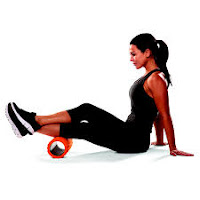Last week, we discussed what fascia is and why it is
important in general. This week, we are
going to talk about why it is important for athletes specifically. Of course, these things correlate to the
non-athlete as well. To review…fascia is
a fibrous connective tissue that is literally EVERYWHERE in the body. If you were to remove all tissues except
fascia, you would still have a 3D model of your body. Fascia plays an integral part in how we move,
especially for athletes. Here are 3
reasons fascia is important for an athlete.
1.
Fascia is our body’s equivalent to a sponge!
Think of it this way…when a sponge is dry, it is hard and
very brittle. Thus, with very little
effort, it is broken apart. But…when a
sponge is hydrated, it is resilient and bounces back easily! Fascia is the same! When dehydrated, it becomes brittle and breakable;
but when it is hydrated, its resiliency allows for effortless gliding over,
around and through the muscles without dysfunction. Our stability and ability to move are
determined mainly by the health and hydration of our fascia. This is extremely important for athletes
because movement and stability are everything when it comes to success. Unrestricted mobility gives an athlete the
advantage over an opponent because they are able to do things their competition
cannot do, especially if the opponent is restricted by dehydrated fascia. Stability is important in preventing
injury. Fascia that is properly hydrated
will move and stretch and glide effortlessly over muscles allowing them to
contract at their highest potential then return to its original shape and
position without any integrity loss. Dry
fascia will pull apart and separate from the muscles leading to injury and
muscle dysfunction.
How do we hydrate fascia?
Do we drink more water? Not
necessarily. While keeping your body
hydrated in general will help, that kind of hydration is more for cell and
organ function than fascia. In order to hydrate
fascia, you must have it manipulated. At
Pro Chiropractic, all 5 chiropractors are highly trained in many different soft
tissue techniques, including Graston Technique, FAKTR, Myofascial Release,
Fascial Manipulation, and Rapid Release.
Using these modalities, we are able to rehydrate fascia and rid the body
of “fascial points” (similar to trigger points) that may cause pain or hinder
proper motion. We all know that being
pain free and mobile are very important to athletes of all ages and levels.
2.
Movement variation plays an important role in
fascial hydration.
Movement itself helps to bring hydration back to the fascia,
but that movement must be varied…in both type and tempo. Doing the same repetitive movements can be
damaging to your joints, leading to issues like arthritis, but those repetitive
movements are actually draining the water from the fascia in those particular
directions. When that happens, the
dehydrated fascia turns brittle causing breakage in the tissue leading to
injuries. Changing up the workout
routine, like cross training, can help rehydrate tissues in all directions,
thus keeping the resiliency and preventing soft tissue injuries.

Always always always incorporate proper rest periods into
your workout routine. Rest also helps to
rehydrate the fascia. Think about how
when you walk on the beach near the water…when you step on the sand, you see
the water leave the area where you stepped, but as soon as you lift your foot,
the water returns. It works the same way
with the fascia. When you work out, it
is like stepping on the sand, water leaves the tissues. When you rest, it is like lifting your foot,
water returns.
3.
Fascia is the largest sensory organ in the body!
Research has recently surfaced showing that the fascial
system may be the largest sensory organ in the body and is thought to have six
to ten times more sensory nerve receptors than muscle tissue. In simpler terms…fascia feels more than
muscle. According to Gibson in a 2009
study, when you feel soreness a day or
two after a tough workout, that Delayed Onset Muscle Soreness (DOMS) is actually
coming from the fascia, not the muscles.
Therefore, it is believed that the fascial system is a system of
proprioception (awareness of your body in space). Maintaining hydrated fascia is very important
in your body’s ability to stay aligned and functional which aids in keeping
small issues and injuries from progressing into larger ones. In order to fully utilize the sensory and
proprioceptive qualities of the fascia, all you have to do is keep moving…especially
those varied movements we talked about before!

 If you
or someone you know in the Gallatin Valley area is looking for a chiropractor,
please call Dr. Shea Stark with Pro Chiropractic at 406-219-2462 to schedule an appointment in
our Belgrade, Manhattan, or Bozeman office. Dr. Stark is a board
certified chiropractor and the author of this blog post. To learn more
about Dr. Stark and the many benefits of chiropractic care, please visit our
website: www.prochiromt.com.
If you
or someone you know in the Gallatin Valley area is looking for a chiropractor,
please call Dr. Shea Stark with Pro Chiropractic at 406-219-2462 to schedule an appointment in
our Belgrade, Manhattan, or Bozeman office. Dr. Stark is a board
certified chiropractor and the author of this blog post. To learn more
about Dr. Stark and the many benefits of chiropractic care, please visit our
website: www.prochiromt.com.

























